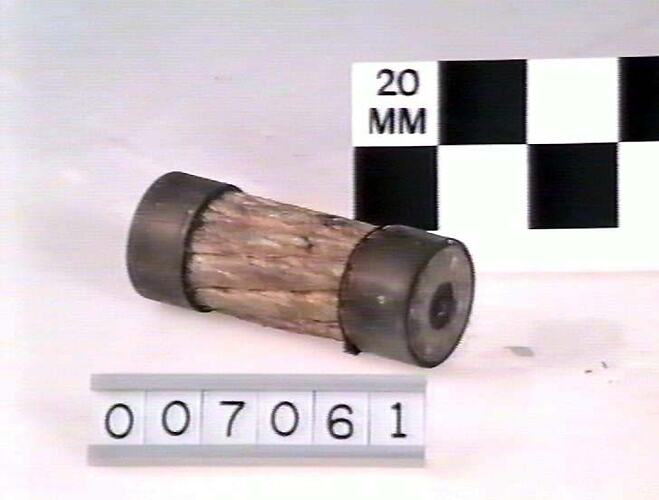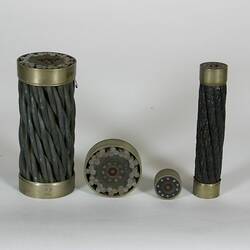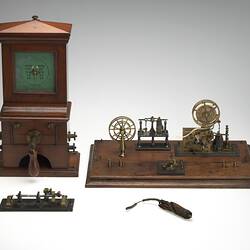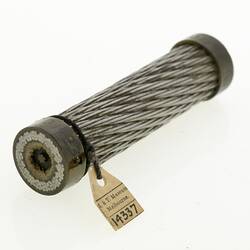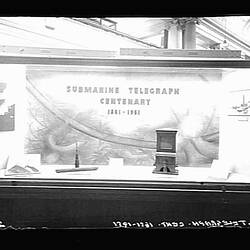Summary
This cable sample shows the structure of the Atlantic Submarine Telegraph cable laid in 1866. Although donated by S. W. Silver and Company, the cable sample matches the description of the 1865 and 1866 Atlantic cables manufactured by the Telegraph Construction & Maintenance Company of London, England.
The cable consists of a central conductor surrounded by a layer of insulation and an outer covering of protective armouring wires. In this case the armouring wires are covered in Manilla yarn. The yarn is not tarred, unlike the 1865 cable when the tar coating caused adjacent turns of the cable to stick together in the storage tanks on the cable-laying ship.
The first attempt to lay a trans-Atlantic submarine telegraph cable took place in 1857 but failed when the cable broke after about 330 nautical miles had been laid. A second attempt in 1858 was successful but the cable operated for only about a month before failing. In 1865 another attempt to lay a trans-Atlantic cable of improved design failed. Finally, in 1866 a cable was successfully laid. In addition, the 1865 cable was retrieved, repaired and completed so that there were two cables in operation by the end of 1866.
The donor of this item was S. W. Silver and Company of London, England. However, the cable was probably manufactured by the Telegraph Construction & Maintenance Co. The Telegraph Construction & Maintenance Co was formed in 1864 and dominated the manufacture of submarine telegraph equipment for the next century. It was involved in the laying of the early Atlantic cables, but not the first. The Company was formed by the merger of the Gutta Percha Company and Glass, Elliott & Company. These were two of the companies who were involved in the laying of the first Atlantic cable.
Physical Description
This piece of cable is a sample of the deep-sea section of the 1866 Atlantic submarine telegraph cable. Each end of the sample is fitted with a circumferential metal band. The folllowing description is based on that given in the book "The Atlantic Telegraph", by W. H. Russell, first published in 1866, republished in 2005 by Nonsuch Publishing Ltd. The copper conductor at the centre of the cable is a strand of seven copper wires, each of No. 18 BWG (Birmingham Wire Gauge), or 1.24 mm diameter. During manufacture the central wire was covered with a thick coating of Chatterton's Compound, a mixture of gutta percha and Stockholm tar, so that when the other six wires were wrapped spirally round it all gaps between the wires were filled. The conductor was then surrounded by a layer of pure gutta percha followed a layer of Chatterton's Compound. The process was repeated three more times to give a total of four layers of gutta percha and four layers of Compound. The core consisting of the conductor and its layers of insulation was wrapped with jute and the whole was armoured by wrapping ten iron wires of No. 13 BWG (2.41 mm diameter) spirally round the core. Each of these wires was itself covered with a jacket of Manilla yarn. The yarn is not tarred, unlike the 1865 cable when the tar coating caused adjacent turns of the cable to stick together in the storage tanks on the cable-laying ship.
Significance
This cable sample illustrates the technology used in the construction of submarine telegraph cables in the mid 1860s. Specifically, it is a sample of the first successful trans-Atlantic cable laid in 1866 between Ireland and Newfoundland.
More Information
-
Collection Names
-
Collecting Areas
-
Acquisition Information
Donation from S.W. Silver & Co
-
Manufacturer (Probable)
Telegraph Construction & Maintenance Co, London, England, Great Britain, 1866
-
Original Source
-
Classification
-
Category
-
Discipline
-
Type of item
-
Overall Dimensions
74 mm (Length), 30 mm (Outside Diameter)
Diameter is measured across circumferential end bands.
-
References
"The Atlantic Telegraph", by W. H. Russell, first published in 1866, republished in 2005 by Nonsuch Publishing Ltd.
-
Keywords
